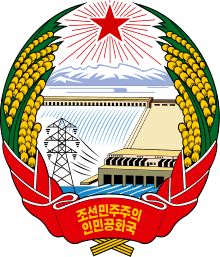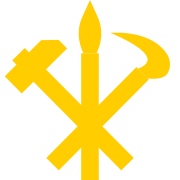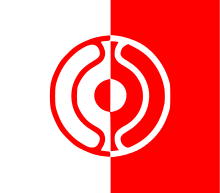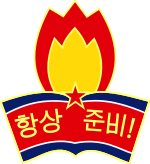Democratic Front for the Reunification of the Fatherland
| Democratic Front for the Reunification of the Fatherland | |
| Chosŏn'gŭl | 조국통일민주주의전선 |
|---|---|
| Hancha | 祖國統一民主主義戰線 |
| Revised Romanization | Joguk tong(-)il minju juui jeonseon |
| McCune–Reischauer | Choguk t'ongil minju chuŭi chŏnsŏn |
 |
|---|
| This article is part of a series on the politics and government of North Korea |
|
|
|
Related topics |
The Democratic Front for the Reunification of the Fatherland (DFRF; also known as the Fatherland Front), formed on 22 July 1946,[1] is a North Korean united front led by the Workers' Party of Korea (WPK). It was initially called the North Korean Fatherland United Democratic Front.[2]
The three political parties of North Korea—the WPK, the Korean Social Democratic Party, and the Chondoist Chongu Party—all participate in the front.[3] The four most important mass organizations—the Kimilsungist-Kimjongilist Youth League, Socialist Women's Union of Korea, General Federation of Trade Unions of Korea, and Union of Agricultural Workers of Korea—are also members.[4][5] The Young Pioneer Corps is also a member.[6]
All candidates for elective office must be members of the front, and are elected by it; mass meetings are held to decide which candidates will be nominated and their names can go on the ballot paper only with the approval of the meeting.[7]
There is an ostensible South Korean counterpart for the DFRF, known as the Anti-Imperialist National Democratic Front, which operates in North Korea.
Members
Political parties
| Organization | Emblem | Foundation | Seats in the SPA (2014) | Ref |
|---|---|---|---|---|
| Workers' Party of Korea |  |
29 July 1946 | 670 | [8][9] |
| Korean Social Democratic Party |  |
3 November 1945 | 50 | [10][9] |
| Chondoist Chongu Party |  |
18 February 1946 | 22 | [11][9] |
Other organizations
| Organization | Emblem | Foundation | Ref |
|---|---|---|---|
| Kimilsungist-Kimjongilist Youth League |  |
17 January 1946 | [12] |
| Socialist Women's Union of Korea | 18 November 1945 | [13] | |
| General Federation of Trade Unions of Korea |  |
30 November 1945 | [14] |
| Union of Agricultural Workers of Korea | 31 January 1946 | [14] | |
| Korean Children's Union |  |
6 June 1946 | [15] |
References
- ↑ "Democratic Front for the Reunification of the Fatherland". Naenara.kp. 2004. Archived from the original on 4 December 2008.
- ↑ Andrei N. Lankov (2001). "The Demise of Non-Communist Parties in North Korea (1945–1960)". jhu.edu. Retrieved 8 September 2015.
- ↑ "Democratic Front for the Reunification of the Fatherland". An Encyclopedic Dictionary of Marxism, Socialism and Communism: Economic, Philosophical, Political and Sociological Theories, Concepts, Institutions and Practices. Macmillan International Higher Education. 1981. p. 141. ISBN 978-1-349-05806-8.
- ↑ Scalapino, Robert A.; Chun-yŏp Kim (1983). North Korea Today: Strategic and Domestic Issues. Institute of East Asian Studies, University of California, Berkeley, Center for Korean Studies. p. 84. ISBN 978-0-912966-55-7.
- ↑ Lansford, Tom (2015). Political Handbook of the World 2015. Singapore: CQ Press. p. 3330. ISBN 978-1-4833-7155-9.
- ↑ "Korea, Democratic People's Republic of (DPRK) - Organizations". Retrieved 31 August 2006.
- ↑ "The Parliamentary System of the Democratic People's Republic of Korea" (PDF). Constitutional and Parliamentary Information. Archived from the original (PDF) on 19 August 2006. Retrieved 1 October 2006.
- ↑ Lanʹkov, Andreĭ Nikolaevich (2002). From Stalin to Kim Il Song: The Formation of North Korea, 1945-1960. C. Hurst & Co. Publishers. p. 31. ISBN 978-1-85065-563-3.
- 1 2 3 "IPU PARLINE Database: Democratic People's Republic of Korea, Choe Go In Min Hoe Ui". Inter-Parliamentary Union.
- ↑ North Korea Handbook 2002, p. 1128.
- ↑ Tertitskiy, Fyodor (26 November 2014). "Being a minor party in the North: In a totalitarian regime, what do N. Korea's other political blocs do?". NK News. Retrieved 25 May 2018.
- ↑ North Korea Handbook 2002, p. 391.
- ↑ North Korea Handbook 2002, p. 390.
- 1 2 North Korea Handbook 2002, p. 389.
- ↑ North Korea Handbook 2002, p. 929.
Works cited
- North Korea Handbook. Seoul: Yonhap News Agency. 2002. ISBN 978-0-7656-3523-5.